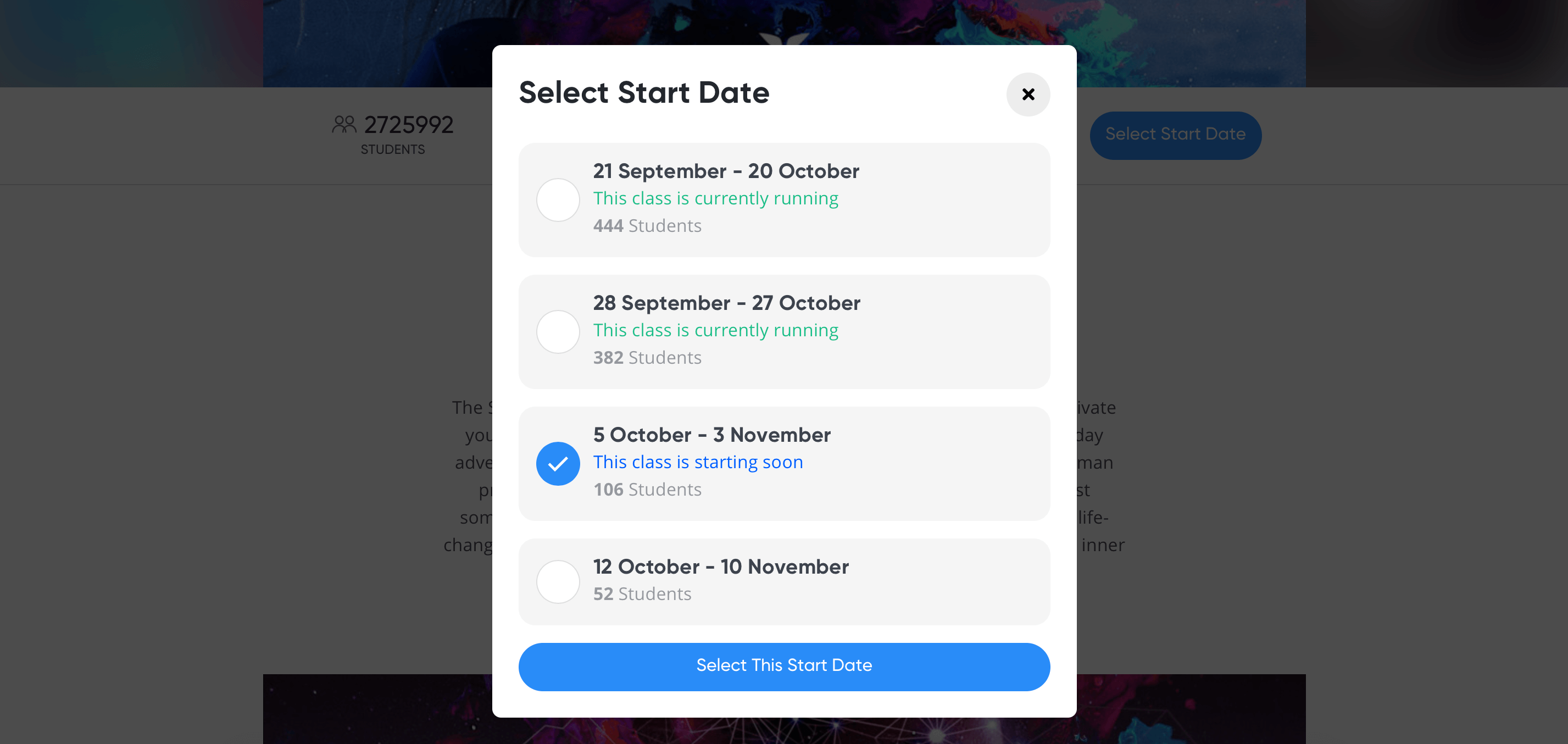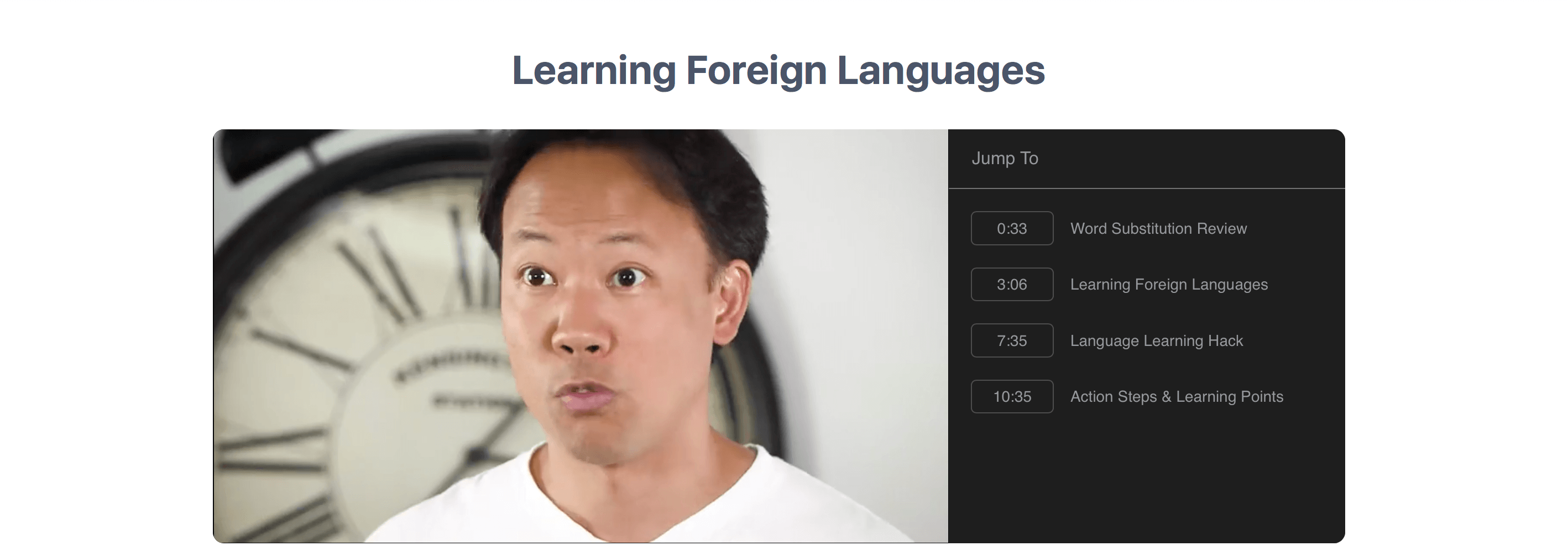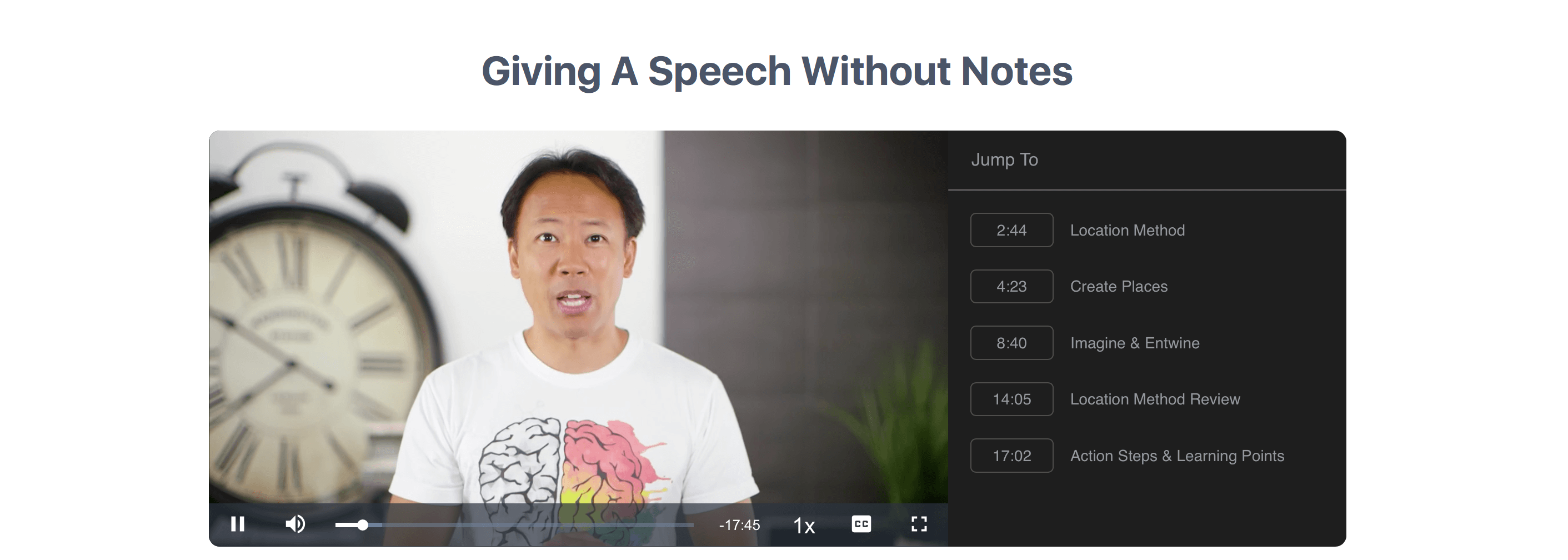I’ve been interested in Mind Valley for a while as I’ve seen a ton of their adverts. Particularly interested in Jim Kwik’s Super Reading and Super Brain Courses, but after getting complete access to the site, there are tons more video courses that I can’t wait to dive into (the ones on yoga, sleep, and business look amazing).
This review is for Jim Kwik’s Mind Valley Super Brain Course Quest.
The Super Brain course is a 4-week premium video course memory-boosting boot camp with tremendous production value, a great syllabus, and staggered lessons.
What does staggered lessons mean?
It means you are held strongly accountable and progress in real time through the lessons.
Each course is scheduled to begin every other week, and you start from the beginning only progressing on the designated day.
You do the exercises and lessons in Day 1, then must wait until Day 2 to proceed.

There’s regular course start dates for Super Brain.
You can still binge the Super Brain course if you like, by enrolling in an earlier scheduled course and seeing the backlog of lessons stored up.
I personally like the staggered approach, and feel that having lessons every day on a specific facet of memory development is more beneficial than watching everything in the course at once (to be honest, it’s too big to do that anyway – after all Mind Valley does call the programs “Quests”).
One of the main drivers of the course is the homework assignments in every module.
As Jim says:
“Knowledge is not power. Knowledge only becomes power when you roll up your sleeves and you do it.” (Jim Kwik, Super Brain)
One of the things I love about the Super Brain Quest is Jim’s patter.
It’s funny because this was initially, before I knew anything about Mind Valley, the thing that put me off the courses. I don’t know where Jim lives, but he seems very “LA” in his manners. Although I lived in nearby Scottsdale in my younger years, I’m still a self-deprecating Londoner at heart – but this wasn’t a big hurdle to get over at all.
But once you’re enrolled in the course, Jim’s words and ideas stick in your mind effortlessly because he’s actually applying what he’s teaching you as he’s teaching it. It feels fun, unforgettable, and makes the whole process a blast.
You end up developing a strong rapport with Jim really fast.
Super Brain, along with the homework assignments, is broken down into four main parts:
- Techniques
- Toughness
- Theory
- Tribe
This is a big course, and it’s broken down by days – new day, new information, new learning assignments, new video module – so I won’t cover every single module in detail here.
I’m going to select a few of my favourite days and modules. They were all pretty great, all enjoyable, all informative, and fit together like pieces in a big puzzle. But this Super Brain review will focus on the ones I liked the looks of.

One of the video modules from Day 19 of the Mind Valley Super Brain Quest – Jim Kwik teaching you how to remember names.
One of my favourite parts of Super Brain were the state exercises: changing your physiology changes your psychology – when you move, the brain grooves.
Super Brain kicks off with a module on how to take notes
I was intrigued to see a prepatory video on how to take notes. As I’m something of an expert on the topic of note-taking and marginalia (a system I developed for myself during my Oxford University career and taught others has been greatly beneficial to my reading), I wasn’t going to let Jim off lightly with this topic.
I was keen to see if there was anything new he could teach me. As he had instructed me in the previous video to “forget” what I thought I knew about the subject, I decided to go into this module with a mind open like a parachute.
“Sell your cleverness and buy bewilderment.” (Rumi, Persian Poet)
Jim’s note-taking system, or at least this prep intro video to the whole course, is based on this one fundamental approach, which he calls ‘capture create’ and involves a way of dividing the page in your notebook.
This isn’t a technique I’ve used, at least not for a very long time, so it did seem like a fresh and new recommendation for me.
I used a variation of this note-taking system, albeit perhaps a little more convoluted back when I was learning Japanese and I found it very beneficial.
Before you dive into the syllabus, you also go through Jim Kwik’s morning routine with him, which includes 10 morning habits geniuses use to jump start their brain.
This warm-up is basically a guide to setting up a cerebral morning routine. There were some interesting habits here that I’m excited to implement – I particularly like the dream-recall habit.
The first two days of Super Brain dive right into actionable and unforgettable memory techniques.
You learn acronyms that are designed to hook onto your motivation for learning something.
These were incredibly insightful, poignant, and endlessly actionable modules.
They were also the best place to start.
Once you know the information in this module, you can’t unknow it.
That means it will be a strong automatic (if you want it to be) part of your brain toolkit for the rest of your life.

Jim Kwik on language learning memory techniques.
You can, should, and will bring this philosophy into any educational pursuit you find yourself embarking upon.
You’re also tested on your memory before learning techniques, like putting the “basic association” tool into our super brain toolbox, and then retested once you know the technique to show you’ve learnt it (and solidify it in your brain through implementation).
One aspect of the Super Brain Mind Valley course that I really loved were the “implementation days”.
Each day, you learn about a different facet of memory and retention – might be diet, might be spaced repletion – but every few days you have an implementation day where you evaluate your success so far (and celebrate it), get some homework (or “fun work” as Jim calls it), and go back to anything you might have missed and double down and go deeper on things you’ve been interested in.
As someone who has learnt languages and skills and designed my own effective syllabuses, I love this idea of an implementation day and know from first-hand experience just how effective it is.
The end of the first week, days six and seven, really stood out because they were all about your learning environments, doing something called “killing ants”, sleep, and stress management.
Day six was a deep psychology, NLP-influenced life hack lesson – not just great for improving your memory but for living better too.
It was a guide in combatting negative self-talk and replacing it with positive self-talk.
Jim goes into the ABRA technique (most of these techniques are built on easy-to-remember acronyms so you can access this information right when you need it, retrieve it from your brain), a technique that will come in handy any time you’re feeling stressed, grief, anger, or any unwanted emotion that you would like to swap for a positive one.
“Your brain is like a supercomputer and your self-talk is the program it will run.” (Jim Kwik, Super Brain)
Day seven was about stress and sleep management.
There is a strong emphasis on memorising lists or words and how to make memorisation easier. All of these principles build upon each other and Jim gives you a lot of different options that once you know them you can’t unknow them.
Now, if the Super Brain course was just about list memorisation I wouldn’t be too impressed, but it’s definitely about more than that.
What I really like is the fact that Jim is actually using these techniques (like the chain-linking technique spread across two videos in the second week) in order to teach wider more abstract and generally applicable principles.
In the chain-linking method videos, you might be learning one technique – and putting it into practice immediately – but you’re also downloading a few new paradigms for how to think about memory – these come in the form of nine fundamental memory principles.
I thought my taking Jim’s Super Brain Mind Valley Quest was quite unique as I couldn’t help but compare his course with my own courses and critique his teaching.
I have a very similar course on memory techniques available (How to Study like an Oxbridge Student) and as I’m a course creator, teacher, and educator myself I found myself picking up on what Jim did well as a teacher, and noticed he was doing a few things that I love to do and have found effective for teaching students over the years.

Day 21 of Super Brain teaches you how to give a speech with notes using the memory palace technique.
One of these things is what I call a “call-and-response” question-and-answer technique.
Jim throws out a term, then asks what that means, and clarifies it.
He is always defining what he is talking about.
So you get the sense that you’re listening to a walking talking encyclopaedia.
He also has a lot of repetition hook points and takes advantage of spaced repetition, baking this powerful principle based on primacy and recency, right into his syllabus.
Basically, take it from on educator reviewing another, Jim is doing a lot of stuff right in this course.
It was also interesting to see how Jim handled some of the same material I’ve taught, like the Peg System.
Jim uses this one in the context of a list of words, whereas I focused on using it in regards to learning dates. So it’s important to point out that this is a very powerful system and will be your friend not only if you want to memorise lists but if you have to learn a lot of different dates like Law or History students.
Another cool thing that I like about Jim Kwik as a teacher is that he’s not afraid to be esoteric. That’s the sort of teaching I like.
In the “implementation day” between week 2 and week 3 of the Super Brain course, he teaches you how to juggle.
Oxford University found jugglers have bigger brains, so there’s Jim teaching you to juggle every day, teaching you how to start from scratch and build up, as part of a daily routine to improve the size of you grey matter. Love it!
I also loved the Super Brain live call during the implementation day.
This was an hour-long Q&A bonus in which people from the “tribe” submitted questions to Jim about learning and memory and habit and routine, and he covers a ton of stuff that’s not in the course syllabus.
He talks about lockdown and quarantining, morning routines when you’re raising children, cold showers, motivation, remember things during stressful situations, best advice for college students to study effectively, accessing the subconscious, and much more.
This was a really great bonus for the Super Brain course and provided a ton of value just by itself.
Jim’s advice for students, I found was particularly insightful and hit upon some techniques that aren’t the norm or typically prescribed study techniques.
One of my personal favourite modules (actually there are several) was on the one that teaches you to remember people’s names.
I’m okay with remembering names, but as the amount of people I have contact with on a daily basis has increased dramatically over the years, I found that I wasn’t quite as good as I thought I was.
I used to pride myself on always connecting a face to a name, but I discovered that only worked when I didn’t meet too many people.
As I had to engage with more people, I tried a lot of ad hoc techniques I came up with myself (like keeping a spreadsheet of names) that didn’t work well.
I’ve since applied Jim Kwik’s techniques for remembering names and they work incredibly well.
They work particularly well when reading long difficult Russian novels like Crime and Punishment:
One of the main memory techniques is based on something FDR, the 32nd President of the United States used to do.
Another one of my favourite “implementation days” involved yoga.
So you’re taking this course, or “Quest”, on improving your brain and memory and you get these little breaks along the way – learn to juggle, refresh, superbrain yoga session, refresh – and I love that.
I think traditional education, schools, and universities should be taking notes.
What I’ll say is this is not full-on yoga, but rather a mini physical practice you can establish to break up your studying routines.
On a related note, if you get the Mind Valley All Access Pass, you can try their other courses too and they have some great yoga courses which are perfect for beginners and more seasoned veterans of the practice.
I had my analytical eye on the third week of the Super Brain course because it was all about how to learn languages, with Jim specifically teaching Japanese words.
I spent years living in Tokyo learning Japanese and I know what works and doesn’t work for most people.
I’ve also taught Japanese vocabulary to exemplify a principle of memorisation (visualisation) in my own study habits course (the similarities between Jim’s course and mine are startling, but I swear I hadn’t seen any of his stuff when I made mine).
Now, I have to point out something I personally had a small problem with. In one of the language learning modules, Jim teaches how to count to ten in Japanese. I can attest that the memory techniques he teaches work, and they’re an important part of a language learning practice, but Jim can’t speak Japanese. I can tell from his pronunciation that these are words he has seen written but not heard natives use extensively.
That’s fine, but it would be nice to have heard him talk about his language learning experiences, what languages he does know, and how he personally put the techniques taught in this course into practice. A little bit more personability would have been better. But that’s just my personality – I like things be a little more personal and I like to hear personal experiences rather than theory.
The “How to Give a Speech Without Notes” module was a great one.
Basically Jim dives into something called the “method of Loci” or the memory palace.
Again, I can attest to the efficacy of this memory technique and applied it during my Finals exams at Oxford University.
I’ve used it for speeches too, and it’s great, but it really does come into its own when it comes to sitting exams, so remember that.
I still have quite a lot of content left to get through with the Super Brain course.
As I said at the beginning of this review, the content is staggered depending on when you sign up. So, looking ahead at the syllabus for week four and some of the bonus content, it looks like we’ll be learning a lot more mnemonics.
I am particularly intrigued about the ancient alphanumeric code of memory module, as that one doesn’t ring any bells. There’s also a class called the five levels of transformation and bonus videos about topics like speed reading, muscle memory, and remembering your dreams – all topics that have deeper long-form video courses as part of the Mind Valley All Access Pass.
Would I recommend Jim Kwik’s Super Brain Quest?
Is Mind Valley worth it?
Super Brain is a great course.
There’s no doubt it is expensive.
I’m no stranger to paying people what they’re due and I’m really big into the belief that premium education commands premium prices.
Good teachers should be well remunerated. I believe they’re as valuable to society as doctors, if not more than.
So when I see a course like Jim’s that’s several hours long, has years of expertise poured into it, has insane production value, fantastic syllabus layout, and basically a ton of time, effort, and money has been put into this course – yes, paying a few hundred bucks for the course is very fair and you do get more than you paid for.
But to make it even better value for money, I highly recommend you pay for the entire Mind Valley catalogue.
Rather than pay hundreds for one course, you can pay the same amount and get so much more.
If you enjoy Super Brain, you’ll obviously enrol for the Speed Reading course with Jim Kwik (that’s my next review), and you’ll probably enjoy the yoga and fitness and lucid dreaming courses or be intrigued about some of the lifestyle design stuff.
There’s tons of great premium content over at Mind Valley, so check out their catalogue and I’m sure there will be a bunch of stuff that you can get a lot out of.
People don’t think twice when it comes to paying for Netflix. But something that’s priced the same and has educational value is something people quibble over.
Don’t think twice. If you like the look of it, it’s worth, go for it, it will be a great investment, and I believe Mind Valley is worth it.
